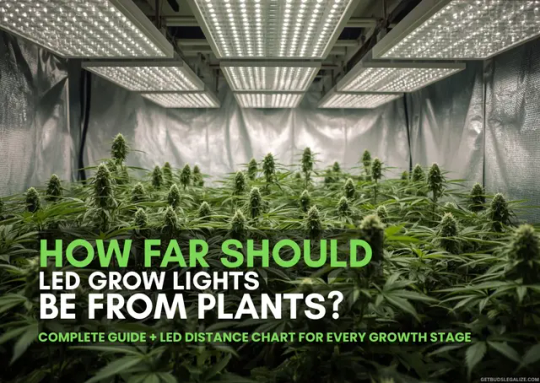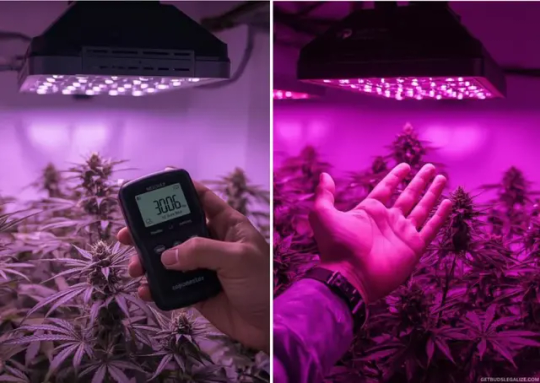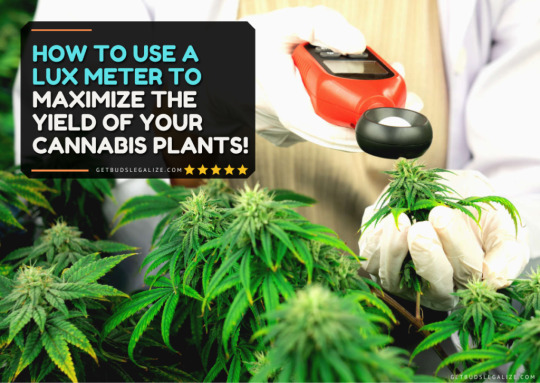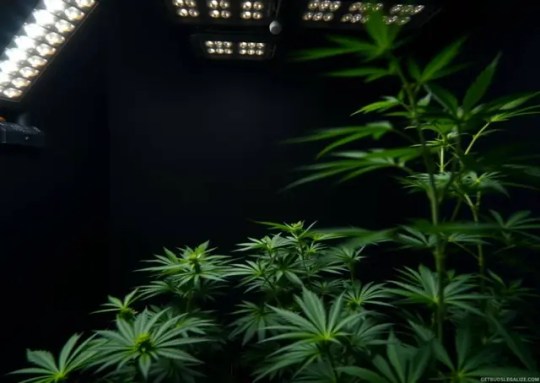#optimallightdistance
Explore tagged Tumblr posts
Text
How Far Should Grow Lights Be From Plants? LED Distance Guide for Every Stage



How Far Should Grow Lights Be From Plants? LED Distance Guide for Every Stage
Are you wondering how far grow lights should be from plants like cannabis, seedlings, or potted herbs? Setting the correct LED grow light distance can make or break your harvest.In this guide, you’ll learn exactly how far to hang grow lights at each growth stage—from seedlings to flowering weed plants—plus how to use PAR meters and light charts for optimal results.Whether you’re growing cannabis, herbs, or vegetables indoors, dialing in the right grow light height ensures your plants get ideal light levels without burning or stretching.
Why LED Light Distance Matters
The distance between your grow lights and plant canopy plays a critical role in overall plant health and yield. If the lights are too close or too far, you risk stunting growth or weakening your crop.Key Benefits of Correct Light Distance:- Photosynthesis Efficiency: Proper distance ensures plants absorb the right amount of PAR (photosynthetically active radiation). - Plant Structure & Internode Spacing: Prevents stretching, encourages tight node spacing. - Nutrient & Water Uptake: Light intensity influences how well plants process water and nutrients. - Bud Development & Aroma: Strong, even lighting supports denser buds and terpene production.Too close? You risk leaf curling, light burn, and heat stress.Too far? Expect lanky, weak plants with reduced yield and potency.



What Affects Grow Light Distance
Finding the right LED grow light distance for cannabis isn’t one-size-fits-all. The ideal height depends on the light spectrum, plant growth stage, and type of LED light you’re using. Here’s how each factor shapes your lighting strategy:1. Light Spectrum & IntensityDifferent spectrums affect growth in different ways:- 3000K (Warm White): Rich in red and far-red wavelengths. Best for the flowering phase when buds are forming. - 5000K (Cool White): High in blue light. Promotes short, leafy growth, ideal for seedlings and vegging. - Full-Spectrum LEDs: Blend of blue, red, and far-red light. Mimic natural sunlight and support all growth stages in one fixture. - Red (600–700 nm) & Far-Red (700–750 nm): Encourage flowering, resin production, and plant stretching when needed. - Seedling Stage (100–300 µmol/m²/s): Keep lights higher or dimmed. Too much intensity will stress young plants. - Vegetative Stage (400–600 µmol/m²/s): Boost light levels to drive stem and leaf development. - Flowering Stage (800–1000 µmol/m²/s): Maximize intensity to encourage dense buds and rich cannabinoid production. - LED Panels: Compact and budget-friendly, these are ideal for beginners or small grow tents. However, they often provide uneven light distribution, which can cause inconsistent growth in larger setups. - Bar-Style LEDs: Designed for even light spread across the canopy, these fixtures minimize hotspots and shadows. They’re perfect for maximizing yields in tents and professional grow rooms. - COB LEDs (Chip-on-Board): Known for their high-intensity output from a concentrated source, COB LEDs penetrate deep into dense canopies. They generate more heat than other types, making them best suited for small, well-ventilated grow spaces requiring focused lighting. Correlated Articol:

How to Choose The Best LED Grow Lights for Cannabis Plants?

How Far Should Grow Lights Be Above Seedlings?
Getting the light distance right during the seedling stage is critical. Young cannabis or herb seedlings are sensitive to intense light and heat.Recommended LED Distances for Seedlings by Wattage: LED Wattage Recommended Distance Target PPFD 150W 25 cm (10") 100–300 µmol/m²/s 300W 25 cm (10") 150–300 µmol/m²/s 480W 30 cm (12") 200–300 µmol/m²/s Pro Tips:- Use dimmable LED grow lights or switch to “Veg” mode to lower light intensity and avoid stressing young seedlings. - Watch for plant signals: Stretching upward = light too far; curled or yellow-tipped leaves = light too close. - Maintain ideal environmental conditions: Keep the temperature between 20–25°C (68–77°F) and humidity around 60–70% to support healthy seedling development and prevent shock. - Adjust the grow light height daily with a ruler or tape—seedlings grow rapidly, and proper distance ensures healthy development.
How Far Should Grow Lights Be From Weed Plants in the Vegetative Stage?
As your cannabis plants move into vegetative growth, they need more light intensity to fuel robust stem and leaf development.Recommended LED Distances for Vegetative Growth: LED Wattage Distance Above Canopy Target PPFD 150W 45 cm (18") 300–450 µmol/m²/s 300W 45 cm (18") 400–600 µmol/m²/s 480W 60 cm (24") 500–700 µmol/m²/s Pro Tips:- Measure light distance daily using a ruler or tape—plants in veg can grow rapidly and close the gap to your lights overnight. - Read your plant’s signals: Stretching or pale stems mean the light is too far; curled or bleached leaves mean it’s too close.
Flowering Stage: How Far Should Grow Lights Be From Bud Sites?
During flowering, cannabis plants need high-intensity light, especially red and far-red wavelengths, to produce dense, resin-rich buds.Recommended LED Distances for Flowering Phase: LED Wattage Distance Above Canopy Target PPFD 150W 30 cm (12") 600–750 µmol/m²/s 300W 45 cm (18") 700–850 µmol/m²/s 480W 45 cm (18") 800–1000 µmol/m²/s Pro Tips:- Use a PAR meter to maintain optimal light intensity (800–1000 µmol/m²/s) for maximum bud development. - Adjust light height every 2–3 days—cannabis plants can stretch rapidly during early flowering. - Control canopy climate: Keep temperatures between 24–28°C (75–82°F) and humidity at 40–50% to prevent mold and preserve potency. - Prevent hotspots: Use bar-style LED grow lights for even light distribution across the canopy. - Rotate your plants weekly to ensure all bud sites receive consistent, balanced light exposure.



How to Measure Grow Light Intensity Accurately
Proper grow light height is important, but without the right intensity, plants can still underperform. Use tools and techniques to dial in the best lighting for every phase.Method 1: Use a PAR Meter (Most Accurate)PAR meters measure PPFD (photosynthetic photon flux density), which tells you how much usable light is reaching the canopy.Target PPFD Ranges by Growth Stage: Growth Stage Recommended PPFD 🌱 Seedlings 100–300 µmol/m²/s 🌿 Vegetative 400–600 µmol/m²/s 🌸 Flowering 800–1000 µmol/m²/s Method 2: Use the Hand Test (Quick Heat Check)No PAR meter? Try this basic heat test:- Hold your hand palm down at canopy height for 30 seconds. - Assess the heat level: - 🔥 Too hot = Light is too close. - ❄️ Cool or faint = Light is too far. - 👍 Comfortably warm = Likely in the safe zone.⚠️ Note: The hand test only measures heat, not light intensity or spectrum. It’s helpful in a pinch, but investing in a PAR meter provides far greater accuracy and control. Correlated Articol:

How To Use A Lux Meter to Maximize The Yield Of Your Cannabis Plants!



Common Grow Light Mistakes to Avoid
Even with great gear, small errors in light placement can derail a healthy grow. Avoid these frequent mistakes:1. Not Adjusting Light Height as Plants GrowCannabis plants grow fast—sometimes centimeters per day. If you don’t raise your lights accordingly:- 🔥 Tops may burn or bleach - 🌿 Stems stretch weakly toward the light - 🌸 Bud sites suffer uneven development - 🌱 Leaf curling or clawing - ⚪ Bleached tips - ⛔ Stunted early growth - 🌞 Yellow or bleached leaves = Light too intense - 🌱 Tall, stretchy stems = Light too far - 🔄 Curling or tacoing leaves = Heat stress✅ Fix: Monitor your canopy daily. Read the full article
#bestgrowlightdistance#cannabisgrowlightspacing#floweringstagegrowlightheight#fullspectrumLEDgrowlights#growlightdistancecalculator#growlightdistancecannabis#growlightdistancechart#growlightdistanceforseedlings#howfarshouldgrowlightsbeaboveseedlings#howfarshouldgrowlightsbefromplants#howfarshouldgrowlightsbefromweedplants#indoorgrowlighttips#LEDgrowlightdistance#LEDgrowsetupguide#LEDlightdistanceguide#lightburncannabis#optimallightdistance#PARmeterforgrowlights#PPFDgrowlightlevels#vegetativestagelightdistance
0 notes